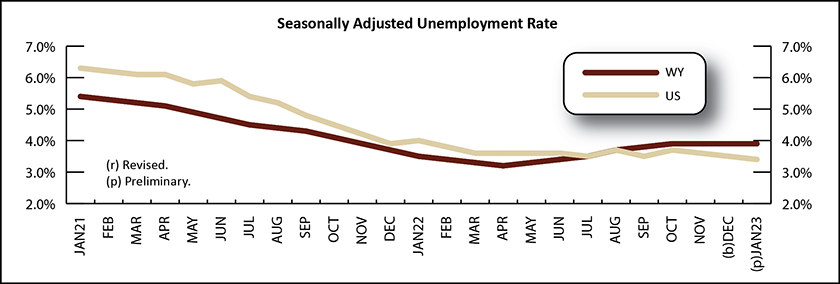Wyoming Labor Force Trends
March 2023 | Volume 60, No. 3
Click Here for PDF
Return to Table of Contents
Wyoming Unemployment Unchanged at 3.9% in January 2023
by: David Bullard, Senior Economist
The Research & Planning section of the Wyoming Department of Workforce Services reported that the state’s seasonally adjusted1 unemployment rate remained unchanged from December to January at 3.9%. Wyoming has recently completed a comprehensive annual revision of its unemployment data. The new data show that Wyoming’s unemployment rate hit a low point of 3.2% in April 2022 and then increased modestly to 3.9% in October 2022. Wyoming’s unemployment rate remained stable at 3.9% from October 2022 to January 2023.
From December to January, county unemployment rates followed their normal seasonal pattern and increased. Unemployment rates usually rise in January because of seasonal job losses in construction, retail trade, professional & business services, and government. The largest unemployment rate increases occurred in Niobrara (up from 3.5% to 4.9%), Fremont (up from 3.9% to 5.2%), Big Horn (up from 4.1% to 5.2%), and Sweetwater (up from 4.2% to 5.3%) counties.
From January 2022 to January 2023, unemployment rates rose in 13 counties, fell in nine counties, and remained unchanged in Crook County (3.6%). The largest increases were seen in Niobrara (up from 3.7% to 4.9%), Platte (up from 3.9% to 4.5%), and Lincoln (up from 3.9% to 4.4%) counties.
Unemployment rates fell in Converse (down from 3.9% to 3.3%), Natrona (down from 5.1% to 4.6%), and Campbell (down from 4.4% to 4.0%) counties.
Teton County reported the lowest unemployment rate in January at 2.7%. It was followed by Weston County at 2.9% and Converse County at 3.3%. The highest rates were found in Sweetwater County at 5.3%, Big Horn County at 5.2%, and Fremont County at 5.2%.
Total nonfarm employment in Wyoming (not seasonally adjusted and measured by place of work) rose from 274,200 in January 2022 to 280,900 in January 2023, an increase of 6,700 jobs (2.4%).
R&P's most recent monthly news release is available at https://doe.state.wy.us/LMI/news.htm.




.svg)
 Wyoming at Work
Wyoming at Work